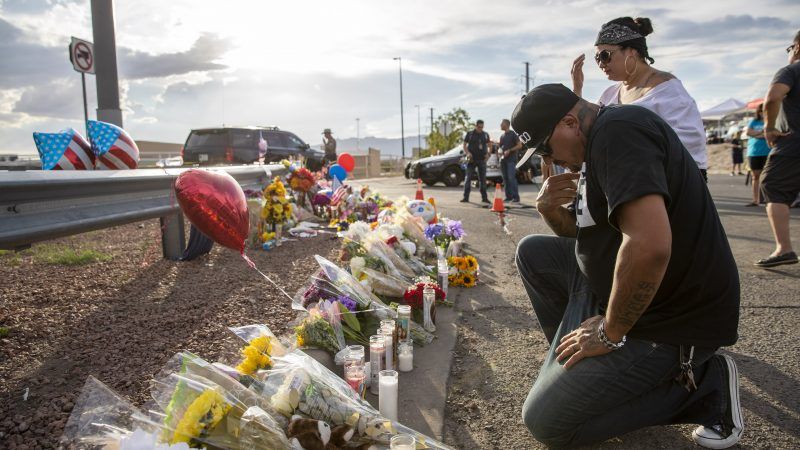Does 'Common Sense Gun Safety Legislation' Make Sense As a Response to the El Paso and Dayton Shootings?
The familiar proposals would do little or nothing to prevent attacks like these.

Hours after a gunman killed 22 people at a Walmart in El Paso on Sunday, Rep. Veronica Escobar (D–Texas), whose district includes that city, implored "all of us who have the power to end this horror" to "come together" and "once and for all address the gun violence epidemic that plagues our nation." Other prominent Democrats, including several presidential contenders, likewise reacted to the attack in El Paso and a mass shooting that killed nine people in Dayton, Ohio, early the following morning by calling for "urgent action" to approve "common sense gun safety legislation."
The elements of that legislation are mostly window dressing that would do little or nothing to prevent attacks like these. The most frequently mentioned policy, "universal background checks," is plainly irrelevant to these particular crimes, since both the El Paso shooter and the Dayton shooter purchased their weapons legally, meaning they did not have disqualifying criminal or psychiatric records. Nor do the vast majority of mass shooters, who either passed background checks or could have. Neither requiring background checks for private transfers nor creating "strong background checks," as President Donald Trump has proposed (perhaps referring to the same policy), would make a difference in such cases.
Democrats also reiterated their support for a federal ban on "assault weapons," and the conservative New York Post editorial page agreed. That policy is at least superficially more relevant, since both of the rifles used in these two attacks would qualify for that label. The El Paso shooter seems to have used a WASR-10 rifle, a civilian, semi-automatic version of the AK-47, while the Dayton shooter used an AM-15, a semi-automatic rifle made by Anderson Manufacturing that's similar to the Colt AR-15.
The focus on such "military-style" rifles is puzzling for a few reasons. In 2017 all rifles combined—only a subset of which would qualify as "assault weapons"— accounted for just 5 percent of gun homicides where the type of firearm was specified, while handguns accounted for 89 percent. Handguns are also the kind of firearm chosen by most mass shooters (whose crimes, it is worth remembering, account for just 1 percent of gun homicides).
Even if Congress passed a new ban on "assault weapons," more than 16 million would remain in circulation, according to an estimate by the National Shooting Sports Foundation. That's an ample supply for the tiny minority of murderers who prefer them. But even if Congress could make those guns disappear—say, by confiscating them through a mandatory "buyback" program, as Rep. Eric Swalwell (D–Calif.) proposed during his short-lived presidential campaign—it would not have a noticeable impact on the frequency or lethality of mass shootings.
Consider the rifle used in El Paso. Judging from security camera images, it had a fixed stock, which is OK under the latest version of the proposed federal "assault weapon" ban, sponsored by Sen. Dianne Feinstein (D–Calif.). The pistol grip would have to go, and so probably would the "upper handguard," which seems to qualify as a forbidden "barrel shroud." But you would still be left with a weapon that fires the same ammunition at the same rate with the same muzzle energy.
One "common-sense" gun control policy that might have practical significance in the context of a mass shooting is a limit on the size of magazines. Feinstein's bill, for example, would ban "large capacity ammunition feeding devices," defined as those that hold more than 10 rounds (such as the magazines used in El Paso and Dayton, but also the magazines that come standard with many kinds of rifles and handguns). As with the "assault weapon" ban, that provision would leave millions of newly illegal products in circulation. But if it made magazines that hold more than 10 rounds more expensive and harder to come by, it could theoretically encourage some mass shooters to use 10-round magazines, which would force them to switch magazines more frequently.
Since it takes just a few seconds to switch magazines, it's not clear how often this constraint would make a difference in attacks on unarmed people. But we can't rule out the possibility that it would occasionally help victims escape or resist. By the same token, however, a magazine that holds more than 10 rounds can make a crucial difference for people using guns to defend themselves against attacks, especially when they are confronted by multiple armed assailants.
U.S. District Judge Roger Benitez emphasized that point, citing actual incidents, when he ruled last March that California's 10-round magazine limit is inconsistent with the Second Amendment right to armed self-defense. "California's law prohibiting acquisition and possession of magazines able to hold any more than 10 rounds places a severe restriction on the core right of self-defense of the home such that it amounts to a destruction of the right and is unconstitutional under any level of scrutiny," he said.
Writing in The New York Times, SUNY Cortland political scientist Robert Spitzer calls that conclusion "startling," "suspect," and "downright strange." Yet it hardly seems strange to point out that the ability to fire more than 10 rounds without switching magazines can be important in self-defense—a point that current and retired police officers make every time they demand exemptions from laws like California's. Indeed, the case for banning "large capacity" magazines hinges on the same observation as the case against banning them: A few seconds can be the difference between life and death.
Show Comments (267)